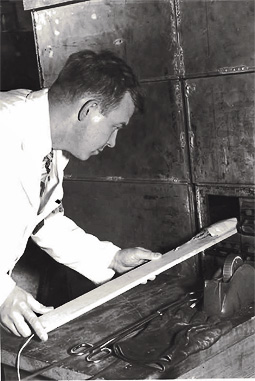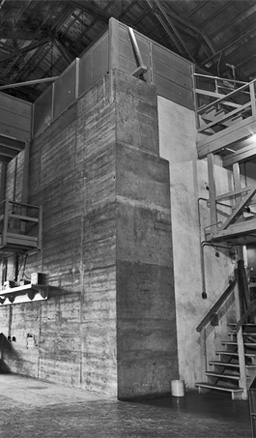Met Lab & Argonne’s Early History

DOWNLOAD as PDF: Full set of interviews [1.2MB] | This page only [222KB] |
Those early days as we remember them (Part VIII)
by E. W. Rylander
Director, ANL Information Services 1959-1969

Elmer Rylander inserting corn tassels into the thermal column of CP-3 in 1946. The irradiated pollen was used in a research program conducted by Thad Pittenger at the University of Nebraska.
It was cold that night in ’43. The Bluebird bus ground to a halt at Budniks Drugstore in Lemont. As I walked down the main street, the stillness of the night was invaded by the bells of the countless churches in that quaint town. It was New Years Eve. Midnight. I reached the end of the street and my goal: Matt’s Tavern. Engulfed by the warm, yeasty air, I found compassion in a stein of beer. I had spent the day in the “Counting Room” of Site A measuring the radioactivity of air samples taken near CP-2.
Site A was the secret laboratory nestled in the Argonne woods of the forest preserve, about five miles from our present site. And, as everyone knows, the woods was named after the World War I Battle of the Argonne. CP-2, Chicago Pile No. 2, was the original West Stands reactor (a term not used then) rebuilt, enlarged, and shielded. It was a leaky reactor — a pile of graphite and uranium metal and oxide surrounded by concrete — a 30-foot cube with many experimental openings.
Site A at that time consisted of one building in which we worked, ate and slept. We had a ladies’ dormitory, too — for the one girl in our midst, Leona Woods, today Leona Libby, who was Fermi’s right-hand girl. The counting room was one of two air-conditioned rooms in the building (the other was the adjacent control room). Located below ground, it contained an array of counters or scalers built by Tom Brill. Each had a cute name such as Heffalump or Winnie Poo. Walter Zinn, (V.P. Combustion Engineering, retired) — he with the hard-shell finish, later to become Argonne’s Director — frequently slept in the room during hay fever season.
Just inside the guard post of Site A, and about 100 yards from the reactor, stood a poured concrete bunker. I often wondered of its purpose. Years later I was told that it was intended to be the control room for the first test of chain reaction (CP-1). The experiment was carried out at The University of Chicago because Site A had not been completed. Because of wartime shortages, wire-carrying conduit was exhumed for use elsewhere.
CP-2 had a thermal column atop it — a graphite wick which brought slow neutrons out of the reactor below. I recall Leona Woods irradiating metal foils in the graphite, quickly removing them, slipping them to a wire she had installed. The foils slid down the wire to the waiting hands of Fermi, who would dash to the counters to measure their short half-lives.

Chicago Pile No. 2, located at Site A. During the waning days of this site discussions were held with representatives of the Department of Interior relative to preserving the reactors for public education. A forest preserve official remarked "You’d get greater public attention if you had a two-headed goat".
Image Credit: University of Chicago Photographic Archive, [apf2-00480], Special Collections Research Center, University of Chicago Library.
I mentioned that CP-2 was well-ventilated. Its reactivity would fluctuate to a small degree with changes in barometric pressure. I recall an experiment of Alex Langsdorf’s (Physics), whereby he sealed the cracks with children’s play clay and attempted to replace the air in the reactor (nitrogen was the culprit) with carbon dioxide. Otto Hillig (since retired to Denmark) was in charge of carbon dioxide production. Now Otto is a versatile, practical man. A machinist by title, he possesses an ingenuity that made him a valuable contributor to many experiments. He took particular delight in working for Zinn or Fermi, who referred to him as the “Great Dane.”
Otto was also a practical jokester! To produce the carbon dioxide gas, Otto had a 55-gallon drum which was filled with dry ice and then sealed. To provide heat he had a series of Bunsen burners under the drum, and a hose connected the drum to the reactor.
During the day, Zinn, escorting a visiting Navy officer, stopped by. He looked at the apparatus with a quizzical eye and remarked to Otto. “You had better be careful here. If that lead-off tube gets blocked, you’ll have an explosion.” As the intruders disappeared around the comer of the reactor, Otto slammed a huge piece of sheet metal to the floor. He was last seen that day dashing out of the reactor room with Zinn close after.
AI Wattenberg (University of Illinois) was a frequent user of CP-2 in his study of photoneutron sources. He would irradiate massive samples of sodium, removing them from the reactor only after the bus to Chicago, the Brown Bomber (or was it the Blue Goose?), had departed. He did his measurements out in the woods. Al will also remember his encounter with a ruptured half-gram radium source and the resultant decontamination under the able direction of Fred Pancner (FPD).
Speaking of the necessity for decontamination, it is appropriate to note here Darragh Nagle’s (Los Alamos) encounter with a skunk while walking to Site A through the woods following Bob Nobles’ (AW) wedding in September of 1943. Darragh lost.
Charles Eggler (Physics), in the 1940s, was the nation’s authority for neutron source calibrations, using CP-2 as the tool. The national standard neutron source was located at Site A. Universities and other laboratories would send their sources to Eggler to be measured against Source No. 38, 500 mg radium-beryllium sourcewhich, I’d bet, is still located in the Physics Division. Eggler had a unique physical way of measuring radiation; ask him someday to elaborate!
A favorite pastime during the first winter at Site A was playing game called “peggity.” It involved moving wooden pegs on a board with a cross formation of holes. Fermi was its chief proponent. I recall taking my board home with me at Christmas and my parents watching me with exchanges of knowing glances.
The physicists were as much at home in the student machine shop as in their laboratory. It was not uncommon to see Zinn or Fermi or Herb Anderson (The University of Chicago) at a lathe or drill press. Machinist helper Frank Gotlund (retired), lumped us all together as “Jack Legs” — never did know what that term meant, but I don’t think it was complimentary. To improve our proficiencies, Machinist Herb Ross (OTD) and later Harold Lichtenberger (Combustion Engineering) offered a night course in machine shop practice. My wife still prizes a tack hammer made under Ross’s tutelage.
During the summer of 1943 ground was broken adjacent to CP-2 for a new building to house the world’s first heavy water reactor, CP-3. It seems incredible that the reactor went critical in May of the following year. It was built without complete drawings. I remember, years later, that draftsman Jim Riddick (retired) would seek us out with a question like “How much space do you think there is between the graphite and the heavy water tank?” We’d gesture, “About this much.” Jim would say “Hold it.” He’d pull out his ruler, measure the distance between hands, and head back to his drawing board. His beautiful set of drawings must still be in existence today.
I recall Zinn’s return from an inspection of the just-completed heavy water reactor in Chalk River, Canada. He was particularly enthusiastic about their white tiled, antiseptic building, the antithesis of ours, and with their use of round beam ports. The latter struck a responsive chord since several of us had spent weeks fitting our square, paraffin-lead-shot-filled plugs into the square, warped ports of CP-3.
With the completion of CP-3, it became possible to provide service irradiations to outside requestors: One of our first customers was Dr. Donalee Tabem of Abbott Laboratories. He would convert irradiated gold into a colloid and ship it to MeHarry Medical College for Hodgkin’s disease research. A somewhat unusual experiment involved raising corn plants at Site A and irradiating the tassels for Thad Pittenger of the University of Nebraska. Thad is now at Kansas State University and a member of the AUA Biology Committee. One of our most prolific users of irradiated chemical compounds was a young professor at the University of Illinois by name of Robert Duffield.
In the early days of the project, we had an English visitor with us for about a month. He had come to Site A after a stopover in Canada. We spent long evenings in the control room of CP-3 discussing the project. His name was Allan Nunn May — he was later to be picked up by Scotland Yard and thrown in the brig for spying for the Russians. One day when I was discussing the event with Zinn, I remarked that I had told May all I knew about our reactors. He looked me straight in the eye with a sense of relief and said, “Elmer, if what you know is all that he learned, we have nothing to worry about!” Candid.
One evening in September of 1944, I was in the control room of CP-3 manning the reactor when in burst a bevy of our top scientists. They were concerned. There was trouble at Site W (Hanford) and — Whoops. Out of space.
Those early days as we remember them
Previous: Part VII
Related Information
- Reactors Designed by Argonne National Laboratory: Early Exploration - Early exploration nuclear reactors designed by the Manhattan Project's Metallurgical Laboratory, the direct predecessor to Argonne National Laboratory, began the development of nuclear technology.
- Fermi facts, fables: Colleagues and friends share memories - Reprinted from Argonne Logos, Winter 2002
- From Met Lab to Argonne: Those early days as we remember them - A series of recollections by former staff members who had worked at the Metallurgical Lab and participated in the birth of Argonne.
- The Discovery of Fission by the American Institute of Physics - Listen to illustrious scientists describe the historic events which brought them to understand nuclear fission
- Anniversary – 80 years ago, Leo Szilard
envisioned neutron chain reaction blog post by Rod Adams at the ANS
Nuclear Cafe blog (Sep. 17, 2013) - Remembering
Argonne nuclear pioneer Leo Szilard
Multimedia
- CP-1 Flickr Gallery (by Argonne National Laboratory)
- Argonne nuclear pioneers: Chicago Pile 1 on YouTube (by Argonne National Laboratory) On December 2, 1942, 49 scientists, led by Enrico Fermi, made history when Chicago Pile 1 (CP-1) went critical and produced the world's first self-sustaining, controlled nuclear chain reaction. Seventy years later, two of the last surviving CP-1 pioneers, Harold Agnew and Warren Nyer, recall that historic day.
Last Modified: Tue, September 24, 2013 3:48 PM



